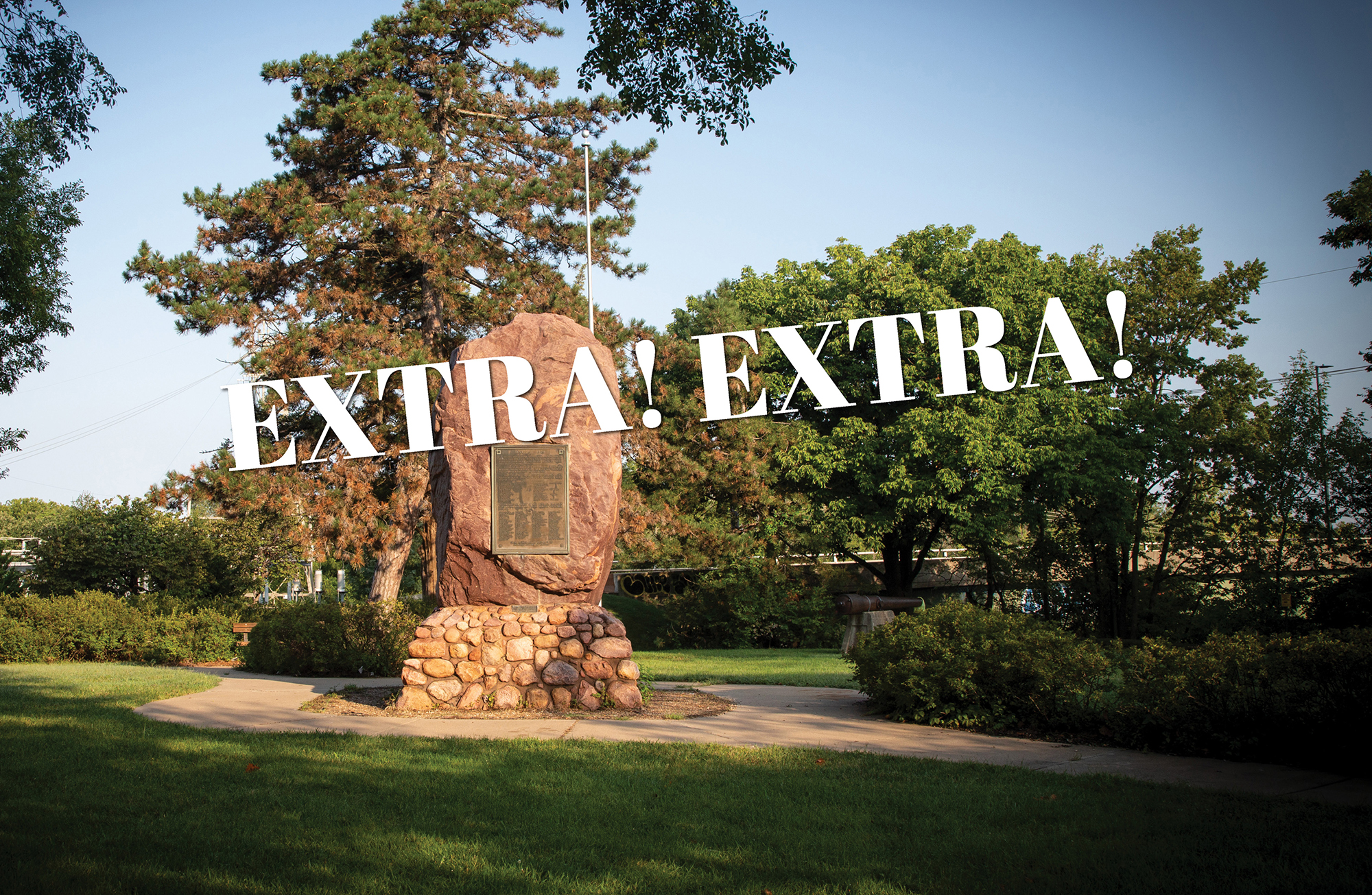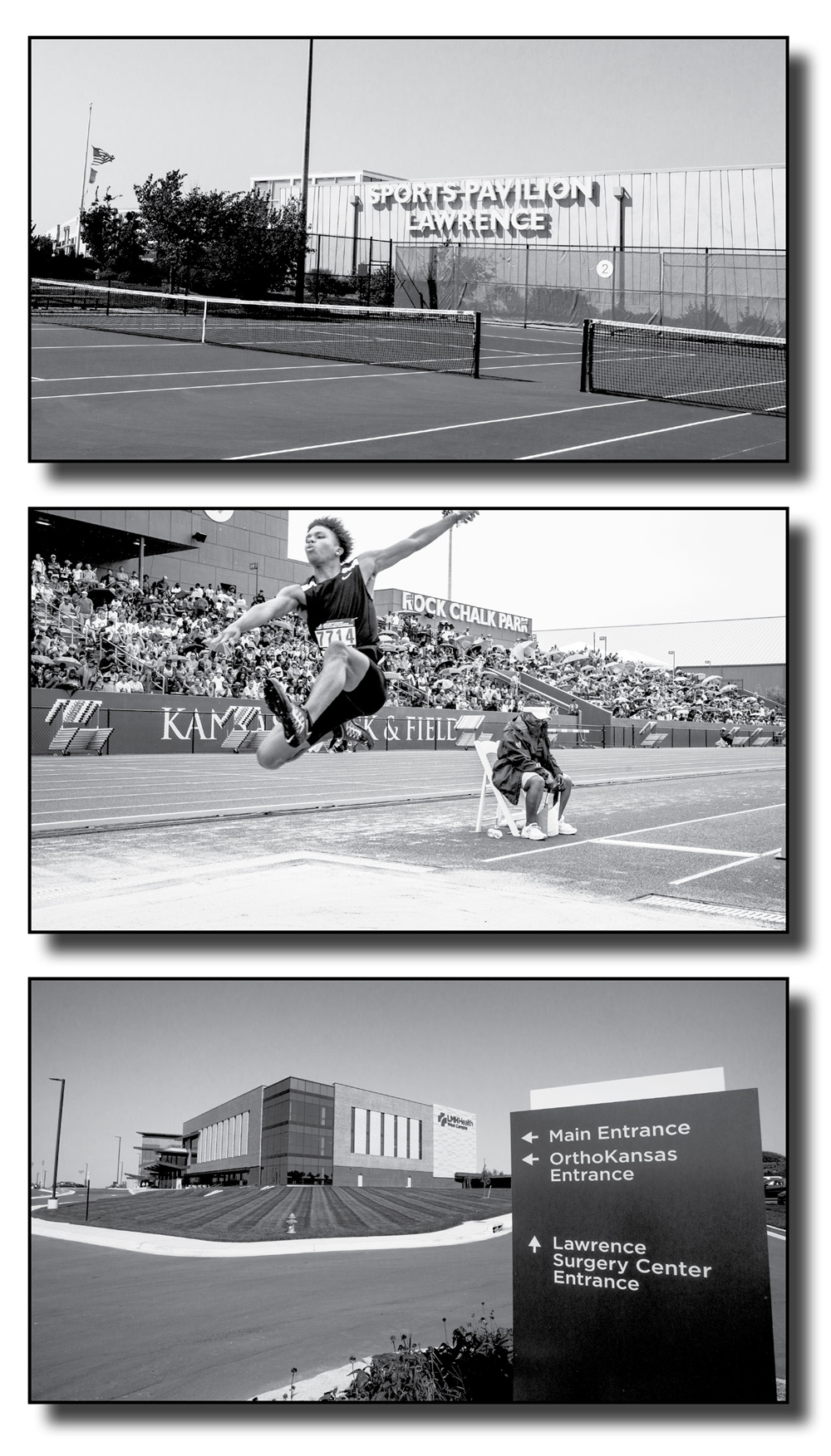| story by | |
| Historical Research & Archival Consulting | |
| photos by | Steven Hertzog |
| OPEN A PDF OF THE ARTICLE |
Discover some of the big events in Lawrence’s history that made the news in the last decade.

The Big Red Rock
What do the Big Red Rock, the South Lawrence Trafficway and Rock Chalk Park have in common? They all were in the news during the last 10 years. These and other events occurred between 2011 and 2021 in Lawrence, as did the creation and publication of Lawrence Business Magazine. This issue marks the magazine’s 10th anniversary.
In 2014, the Sports Pavilion Lawrence opened in Rock Chalk Park. Construction costs for the city’s portion of the complex were capped at $22.5 million and a $2-million donation from Bill and Cindy Self’s Assists Foundation. The recreational facilities included eight full-sized basketball courts, 16 full-sized volleyball courts, 1/8-mile indoor walking and jogging track, and areas for gymnastics, aerobics/fitness and cardio/weights. Administrative offices and meeting rooms are also part of the pavilion.
The University of Kansas also built a sports complex at Rock Chalk Park. Built in 2014, the KU portion of Rock Chalk Park features a world-class running surface that has played host to several prominent national meets since its completion. It includes approximately 90,000 square feet of locker rooms, offices, sports official rooms and a training room and athletic training facilities located under the east stands. The nine-lane track at Rock Chalk Park gives fans a look at some of the top competitors in the country.
In 2016, Rock Chalk Park hosted the NCAA West Preliminary meet, featuring the top NCAA track and field athletes west of the Mississippi River. One year later, Rock Chalk Park held the 2017 USA Track and Field Junior Championships, welcoming some of the top junior athletes in the United States. In addition to these regional and nations meets, Rock Chalk Park hosts numerous KU Track and Field meets a year, including the Kansas Relays.

LBM Covers Generation to Generation 2017Q1 and Preserving & Evolving Lawrence 2021 Q1
The Sports Pavilion and the KU complex benefit from shared parking, landscaping, irrigation, five miles of walking trails and standard infrastructure such as sanitary, sewer, water, stormwater, streets and sidewalks. Proposals for the Sports Pavilion identified the following benefits:
- “The city believes the project is an extraordinary opportunity for the community. Not only does it address our much-needed indoor gym space needs, the project provides the opportunity to host sports tournaments in our city, capturing sales tax revenue from retail sales to out-of-town visitors and recapturing revenues currently lost to other communities. Additionally, the project provides a synergy with the KU Athletic facilities, a synergy that would be unique for the State of Kansas and the entire region. The collaboration allows for the maximization of shared infrastructure.”
Another new development on the west side of the city is LMH Health West Campus. It opened Sept. 14, 2020. Approximately 200,000 square feet in size, the building serves as an outpatient medical office building for LMH Health. The building is just south of Rock Chalk Park at the South Lawrence Trafficway and Sixth Street interchange. Costing approximately $100 million, the structure includes space for the LMH Breast Center, a surgery center for outpatient procedures, an orthopedic center run by OrthoKansas, a physical therapy center, several doctor’s offices and other services.
All of the facilities described above are adjacent to the South Lawrence Trafficway. The improved east leg opened in 2016, but it was preceded by several decades of debate about the pros and cons of improving Kansas Highway 10 (K-10). One writer states: “The South Lawrence Trafficway surely must be the most debated stretch of concrete in Douglas County’s history.” The center of the controversy was the Baker Wetlands (also known as the Haskell-Baker Wetlands), a nature preserve and artificially sustained wetland spanning approximately 927 acres south of Lawrence. It is associated with the Wakarusa River and sustained by levees and flood controls built in the 1990s. In 1969, the U.S. National Park Service declared the wetlands a National Natural Landmark. The wetlands support 413 documented species of vascular plants, 265 species of birds and 61 additional vertebrate species.

Sports Pavilion Lawrence, Junior Olympics at Rock Chalk Park 2017Q3, Lawrence Memorial Hospital
In the early 1970s, traffic studies of K-10 determined a bypass around the west and south sides of Lawrence was necessary, so the Kansas Department of Transportation began studying and planning the bypass project. Completion of the eastern leg of the trafficway was delayed for nearly three decades by lawsuits from environmentalist groups and Haskell University, as the planned route took the highway through the Baker Wetlands. Mitigation plans for the Wetlands were developed and approved. One feature of the mitigation was the construction of a Discovery Center, which opened in 2015. Construction finally began on Nov. 12, 2013 and was completed by fall 2016. The ribbon-cutting ceremony for the trafficway was held on Nov. 4, 2016, and numerous state and local leaders were in attendance. The trafficway officially opened to all traffic on Nov. 9, 2016. By 2018, daily use of the road averaged 17,000 vehicles. Presently, plans for future improvements are being discussed.
Recently, an effort has begun to return a Lawrence landmark, the Big Red Rock, to the Kaw Nation. The name is based on the rock being pink quartzite, and it weighs approximately 23 tons. The sacred prayer rock was moved to its current location in Robinson Park in 1929, and the attached plaque turned it into a monument to the founders of Lawrence. It had been moved from its former location along the banks of the Kansas River at the mouth of Shunganunga Creek, where it had been deposited by a glacier. The Kaw people used the 10-foot-tall red rock in religious ceremonies, and it is believed the tribe viewed it as a sacred place to obtain stone for making ceremonial pipes. Tradition says the Kaw had 89 songs for this rock alone. The tribe’s folklore believes there were “several spirit villages where the souls of warriors and all good dreamers went on to their death” along the Kansas River. In recent years, it has become a point of contention with the Kaw tribe.
On Jan. 19, 2021, the Lawrence City Commission voted to return the Big Red Rock to the tribe. The action was in response to a letter received from the tribe asking for its return. Following the city commissioner’s decision, Kaw Nation chairwoman Lynn Williams informed the commission that at the Kaw Nation General Council meeting in October, Kaw citizens overwhelmingly voted in favor of bringing the boulder back to the tribe. Williams says in the letter that the tribe’s stewardship of the rock and its significance as a spiritual item of prayer was well-documented, and the tribe’s intent was to reclaim that stewardship and restore the rock’s sacred significance. The letter from the Kaw Nation explained it planned to move the rock to Allegawaho Memorial Heritage Park, in Council Grove, Kansas. The park is the site of the last Kaw/Kansa village in Kansas before it was forced to move to Oklahoma. The 158-acre Kaw Heritage Park is owned and managed by the Kaw Nation from their Oklahoma offices. The long-range goal for the park is to create an educational resource center where visitors can learn about the state’s early Native American inhabitants. The City of Lawrence is working with the tribe and community partners to secure grants and other funding to pay for the cost of relocation.
The last 10 years in Lawrence have had numerous significant events. On Oct. 4, 2011, Lawrence was the first city in Kansas to pass an ordinance prohibiting discrimination on the basis of sexual orientation. University of Kansas professor Kevin Wilmott and his collaborator, Spike Lee, won an Academy Award in 2019 for Best Adapted Screenplay for “BlacKkKlansman.” And lastly, all Kansas Jayhawk fans celebrated the men’s basketball team when it won a national record-setting 14 consecutive conference champions from 2005 to 2018. I am sure readers will have many favorites to add to this list.
![]()




